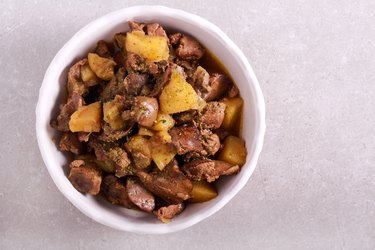
If you've ever fished the innards out of a whole store-bought chicken and wondered what to do with them, or bravely purchased a tray full of raw chicken livers from the butcher, go ahead and eat up. Liver is a fantastic source of protein, phosphorus and potassium.
Chicken Liver Nutrition
Video of the Day
One of the most common ways to cook chicken liver — or really, any liver — is to fry it up. The USDA provides information on chicken liver nutrition. A 1-cup serving of fried, diced chicken liver contains 265 calories. The macronutrient breakdown is 28 grams of protein, 12.1 grams of fat and just under 9 grams of carbohydrate. You'll find barely any sugar — just under 0.03 grams per cup of diced, fried chicken liver — but the liver is rich in calcium (14 milligrams), iron (14.1 milligrams), magnesium (28 milligrams), phosphorus (437 milligrams) and potassium (322 milligrams).
Video of the Day
What about different cooking methods? According to the USDA, if you braise the chicken liver, a diced 1-cup serving contains 232 calories, a whopping 34 grams of protein and 9 grams of fat. Chicken liver carbs come in at just 1.2 grams, and the serving contains zero grams of sugar. That liver also contains a range of B vitamins, notable amounts of copper and selenium, and just under 23 milligrams of vitamin C.
A 1-cup serving of braised chicken liver also yields 15.4 milligrams calcium, 16.2 milligrams iron, 35 milligrams magnesium, an impressive 563 milligrams phosphorus, 365 milligrams potassium and 5.5 milligrams zinc. Chicken liver nutrition also contains notable amounts of copper, selenium, a range of B vitamins and just under 40 milligrams of vitamin C.
Chicken Liver and Healthy Diet
The 30 extra calories per cup that you get from frying chicken liver instead of braising it might not seem like much at first glance. But just like small money expenditures add up fast over time, so do small calorie intakes.
A year of eating fried chicken liver twice a week, instead of braising it or choosing another method, can add up to almost an extra pound of body fat. So if you're at all concerned about losing weight or maintaining healthy weight, it pays to get in the habit of using healthy cooking methods.
That said, eating healthy is also about balance. So if you really love fried chicken liver more than anything else, balance that out by pairing it with a side of steamed greens and whole grains, to boost your fiber consumption and send the meal's mineral content through the roof.
Canada's Half Your Plate has one easy trick for balancing your meals: Make sure your greens and grains, or other healthy side dishes, take up at least half the space on your plate.
Read more: How Healthy Is Eating Liver?
Chicken Liver Cholesterol and Salt
If chicken liver sounds like a fantastic food so far, you're right. But there are a few not-quite-as-attractive details you should keep in mind. Whether fried, braised or cooked any other way, chicken liver tends to be very high in both sodium and cholesterol.
For example, the aforementioned 1-cup serving of fried chicken liver contains 622 milligrams of sodium, and 549 milligrams of cholesterol. One cup of braised chicken liver contains 557 milligrams of sodium and 781 milligrams of cholesterol.
It's also very common to add eggs, onions and other "mix-ins" to your liver — which can send both sodium and cholesterol through the roof. For example, the USDA says a 1-cup serving of chicken liver mixed with eggs and onions has 2,180 milligrams of sodium and 655 milligrams of cholesterol.
That doesn't mean you can never eat these foods. But for the sake of both your health and your waistline, you should be conscious of where they fit into the big picture of your eating habits.
The Department of Health and Human Services offers a table of nutritional benchmarks to help you get that big-picture perspective. They recommend that adults limit sodium intake to 2,300 milligrams per day; following a few easy sodium-reducing strategies can help you attain that goal.
Although the HHS doesn't issue nutrition guidelines for cholesterol intake, the Harvard T.H. Chan School of Public Health recommends that so-called "responders," whose blood cholesterol levels rise and fall markedly in relation to the amount of cholesterol they eat, should avoid cholesterol-rich foods.
The Harvard School of Public Health also notes that trial and error is currently the only way to identify these "responders," so if you think high cholesterol might be an issue for you, talk to your doctor.
- USDA: "Chicken Liver, Braised"
- USDA: "Chicken Liver, Fried"
- HalfYourPlate.ca: "Fill Half Your Plate With Fruits and Veggies"
- USDA: "Livers, Chicken, Chopped, With Eggs and Onions (Mixture)"
- Department of Health and Human Services: "Nutritional Goals for Age-Sex Groups Based on Dietary Reference Intakes and Dietary Guidelines Recommendations"
- Harvard T.H. Chan School of Public Health: "Cholesterol"
Is this an emergency? If you are experiencing serious medical symptoms, please see the National Library of Medicine’s list of signs you need emergency medical attention or call 911.